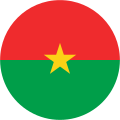 | |
| Use | National flag |
|---|---|
| Proportion | 2:3 |
| Adopted | August 4, 1984 |
| Design | Two horizontal bands of red and green with a yellow five-pointed star in the center. |
| Designed by | Ferdinand Dabiré |

The national flag of Burkina Faso (French : drapeau du Burkina Faso) is formed by two equal horizontal bands of red (top) and green, with a yellow five-pointed star resting in the center. [1] The flag was adopted on 4 August 1984. The flag uses the Pan-African colours of Ethiopia, reflecting both a break with the country's colonial past and its unity with other African ex-colonies. The red is also said to symbolize the revolution and the green the abundance of agricultural and natural riches. The yellow star placed over the red and green stripes represents the guiding light of the revolution. The flag was adopted following the coup of 1983 which brought Thomas Sankara to power. [2]












